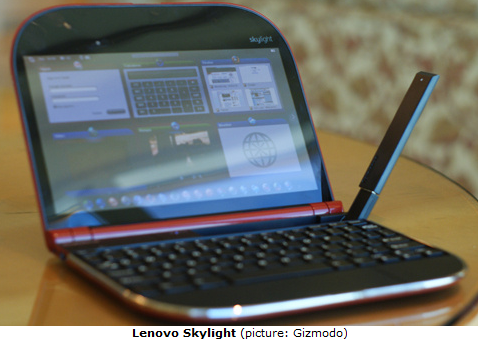CES 2010: With reluctance to slate-only, Lenovo steals the show

CES 2010 is throwing out some interesting new devices, notably the slate device concepts which I've covered before. While the pure-tablet/slate designs aren't exactly my ideal cup of tea, the industry is alive with these new revolutionary concepts.
As my colleague Chris Dawson notes, it seems now they are out, the "tablet form factor is here to stay". But thankfully some are staying with the small and compact devices, while others such as Lenovo are reluctant to go whole-hog and instead offer a dual experience of tablet plus keyboard.
Lenovo Skylight netbook

The Skylight combines both the power of the smartphone and a full laptop unlike the HP/Microsoft slate which harnesses only the aesthetics of these devices. The Skylight is smooth and sleek with no screws or hinges, it's light and it's very compact. It's about the same thickness of a smartphone and weighs just under 2lbs.
It comes with 3G and Wifi combined into the Qualcomm Snapdragon ARM processor, 14GB of flash solid-state storage along with an integrated USB stick (seen above), and a 10" HD screen which shows a clear display whichever angle you look at it from. The 10 hours of battery life will go down a storm in the academic community, allowing you to work literally all day and even past the hour of your final lecture.
Live web gadgets make up the user interface, which incorporate your email, weather, news and social networking sites, negating the need for a "standard" operating system. There are however a limited number of Skylight applications and Lenovo have yet to open up the SDK to developers.
It'll be available from Spring 2010 (this quarter) at $499, or less on a mobile network data contract.
Lenovo IdeaPad U1 hybrid notebook
This could be my favourite device seen in a long while. Priced at $999, the notebook can undock its screen to act independently as a multi-touch device. At the same size as an ordinary notebook, the screen is 11.6" in size and is powered by an Intel Core 2 Duo processor. Once the screen is pulled from the base, it runs in hybrid-Skylight mode, running off the Snapdragon processor with a 16GB solid-state drive.
Lenovo has hit the right note with this device, as a laptop-come-slate device with two brains and two operating systems, giving the user the best of both worlds. But what I love the most is the two are connected; you can browse in Windows then detach the screen and continue where you left off in Skylight-mode. Also, the ability to split between laptop and slate modes gives the student a better offering of both worlds.
Whether you like it or not, a physical keyboard is necessary for academia. You simply couldn't write an essay on a slate device, nor be able to research properly. Lenovo has certainly scored points with me, as these devices are not specifically aimed at students or academia, but they at least have a track record in student based laptops and are continuing to aim these devices at the student-inclusive audience.
Would you buy one of these? Is CES focusing enough on students this year? Leave a TalkBack.